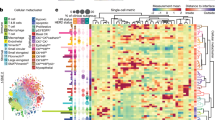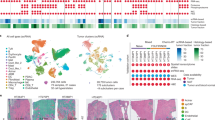Abstract
Intratumoral heterogeneity is a critical factor when diagnosing and treating patients with cancer. Marked differences in the genetic and epigenetic backgrounds of cancer cells have been revealed by advances in genome sequencing, yet little is known about the phenotypic landscape and the spatial distribution of intratumoral heterogeneity within solid tumours. Here, we show that three-dimensional light-sheet microscopy of cleared solid tumours can identify unique patterns of phenotypic heterogeneity, in the epithelial-to-mesenchymal transition and in angiogenesis, at single-cell resolution in whole formalin-fixed paraffin-embedded (FFPE) biopsy samples. We also show that cleared FFPE samples can be re-embedded in paraffin after examination for future use, and that our tumour-phenotyping pipeline can determine tumour stage and stratify patient prognosis from clinical samples with higher accuracy than current diagnostic methods, thus facilitating the design of more efficient cancer therapies.
This is a preview of subscription content, access via your institution
Access options
Access Nature and 54 other Nature Portfolio journals
Get Nature+, our best-value online-access subscription
$29.99 / 30 days
cancel any time
Subscribe to this journal
Receive 12 digital issues and online access to articles
$99.00 per year
only $8.25 per issue
Buy this article
- Purchase on Springer Link
- Instant access to full article PDF
Prices may be subject to local taxes which are calculated during checkout







Similar content being viewed by others
Change history
02 January 2018
In this Article originally published, owing to a technical error, author affiliations were incorrectly assigned in the HTML version; the PDF was correct. These errors have now been corrected.
References
Gerlinger, M. et al. Intratumor heterogeneity and branched evolution revealed by multiregion sequencing. N. Engl. J. Med. 366, 883–892 (2012).
Marusyk, A., Almendro, V. & Polyak, K. Intra-tumour heterogeneity: a looking glass for cancer? Nat. Rev. Cancer 12, 323–334 (2012).
Junttila, M. R. & de Sauvage, F. J. Influence of tumour micro-environment heterogeneity on therapeutic response. Nature 501, 346–354 (2013).
Zhang, J. et al. Intratumor heterogeneity in localized lung adenocarcinomas delineated by multiregion sequencing. Science 346, 256–259 (2014).
Vogelstein, B. et al. Cancer genome landscapes. Science 339, 1546–1558 (2013).
McGranahan, N. & Swanton, C. Biological and therapeutic impact of intratumor heterogeneity in cancer evolution. Cancer Cell 27, 15–26 (2015).
Waclaw, B. et al. A spatial model predicts that dispersal and cell turnover limit intratumour heterogeneity. Nature 525, 261–264 (2015).
Polyak, K. & Weinberg, R. A. Transitions between epithelial and mesenchymal states: acquisition of malignant and stem cell traits. Nat. Rev. Cancer 9, 265–273 (2009).
Plaks, V., Kong, N. & Werb, Z. The cancer stem cell niche: how essential is the niche in regulating stemness of tumor cells? Cell Stem Cell 16, 225–238 (2015).
Wang, K. et al. Whole-genome sequencing and comprehensive molecular profiling identify new driver mutations in gastric cancer. Nat. Genet. 46, 573–582 (2014).
Andor, N. et al. Pan-cancer analysis of the extent and consequences of intratumor heterogeneity. Nat. Med. 22, 105–113 (2016).
Saliba, A. E., Westermann, A. J., Gorski, S. A. & Vogel, J. Single-cell RNA-seq: advances and future challenges. Nucleic Acids Res. 42, 8845–8860 (2014).
Patel, A. P. et al. Single-cell RNA-seq highlights intratumoral heterogeneity in primary glioblastoma. Science 344, 1396–1401 (2014).
Lawson, D. A. et al. Single-cell analysis reveals a stem-cell program in human metastatic breast cancer cells. Nature 526, 131–135 (2015).
Tabassum, D. P. & Polyak, K. Tumorigenesis: it takes a village. Nat. Rev. Cancer 15, 473–483 (2015).
Erturk, A. et al. Three-dimensional imaging of solvent-cleared organs using 3DISCO. Nat. Protoc. 7, 1983–1995 (2012).
Ke, M. T., Fujimoto, S. & Imai, T. SeeDB: a simple and morphology-preserving optical clearing agent for neuronal circuit reconstruction. Nat. Neurosci. 16, 1154–1161 (2013).
Chung, K. & Deisseroth, K. CLARITY for mapping the nervous system. Nat. Methods 10, 508–513 (2013).
Susaki, E. A. et al. Whole-brain imaging with single-cell resolution using chemical cocktails and computational analysis. Cell 157, 726–739 (2014).
Yang, B. et al. Single-cell phenotyping within transparent intact tissue through whole-body clearing. Cell 158, 945–958 (2014).
Hama, H. et al. ScaleS: an optical clearing palette for biological imaging. Nat. Neurosci. 18, 1518–1529 (2015).
Tomer, R., Ye, L., Hsueh, B. & Deisseroth, K. Advanced CLARITY for rapid and high-resolution imaging of intact tissues. Nat. Protoc. 9, 1682–1697 (2014).
Tainaka, K. et al. Whole-body imaging with single-cell resolution by tissue decolorization. Cell 159, 911–924 (2014).
Renier, N. et al. iDISCO: a simple, rapid method to immunolabel large tissue samples for volume imaging. Cell 159, 896–910 (2014).
Belle, M. et al. A simple method for 3D analysis of immunolabeled axonal tracts in a transparent nervous system. Cell Rep. 9, 1191–1201 (2014).
Susaki, E. A. et al. Advanced CUBIC protocols for whole-brain and whole-body clearing and imaging. Nat. Protoc. 10, 1709–1727 (2015).
Eliceiri, K. W. et al. Biological imaging software tools. Nat. Methods 9, 697–710 (2012).
Schneider, C. A., Rasband, W. S. & Eliceiri, K. W. NIH Image to ImageJ: 25 years of image analysis. Nat. Methods 9, 671–675 (2012).
Peng, H., Bria, A., Zhou, Z., Iannello, G. & Long, F. Extensible visualization and analysis for multidimensional images using Vaa3D. Nat. Protoc. 9, 193–208 (2014).
Salois, G. & Smith, J. S. Housing complexity alters GFAP-immunoreactive astrocyte morphology in the rat dentate gyrus. Neural Plast. 2016, 3928726 (2016).
Peinado, H., Olmeda, D. & Cano, A. Snail, Zeb and bHLH factors in tumour progression: an alliance against the epithelial phenotype? Nat. Rev. Cancer 7, 415–428 (2007).
Maier, J., Traenkle, B. & Rothbauer, U. Visualizing epithelial–mesenchymal transition using the chromobody technology. Cancer Res. 76, 5592–5596 (2016).
Savagner, P. The epithelial–mesenchymal transition (EMT) phenomenon. Ann. Oncol. 21, vii89–vii92 (2010).
Connor, J. et al. Regression of bladder tumors in mice treated with interleukin 2 gene-modified tumor cells. J. Exp. Med. 177, 1127–1134 (1993).
Matsumoto, K. et al. Intravesical interleukin-15 gene therapy in an orthotopic bladder cancer model. Human Gene Ther. 22, 1423–1432 (2011).
Kobayashi, T., Owczarek, T. B., McKiernan, J. M. & Abate-Shen, C. Modelling bladder cancer in mice: opportunities and challenges. Nat. Rev. Cancer 15, 42–54 (2015).
Dobosz, M., Ntziachristos, V., Scheuer, W. & Strobel, S. Multispectral fluorescence ultramicroscopy: three-dimensional visualization and automatic quantification of tumor morphology, drug penetration, and antiangiogenic treatment response. Neoplasia 16, 1–13 (2014).
Dodt, H. U. et al. Ultramicroscopy: development and outlook. Neurophotonics 2, 041407 (2015).
Frampton, G. M. et al. Development and validation of a clinical cancer genomic profiling test based on massively parallel DNA sequencing. Nat. Biotechnol. 31, 1023–1031 (2013).
Zheng, Z. et al. Anchored multiplex PCR for targeted next-generation sequencing. Nat. Med. 20, 1479–1484 (2014).
Brat, D. J. et al. Comprehensive, integrative genomic analysis of diffuse lower-grade gliomas. N. Engl. J. Med. 372, 2481–2498 (2015).
Maley, C. C. et al. Genetic clonal diversity predicts progression to esophageal adenocarcinoma. Nat. Genet. 38, 468–473 (2006).
Landau, D. A. et al. Evolution and impact of subclonal mutations in chronic lymphocytic leukemia. Cell 152, 714–726 (2013).
Bochtler, T. et al. Clonal heterogeneity as detected by metaphase karyotyping is an indicator of poor prognosis in acute myeloid leukemia. J. Clin. Oncol. 31, 3898–3905 (2013).
Mroz, E. A., Tward, A. D., Hammon, R. J., Ren, Y. & Rocco, J. W. Intra-tumor genetic heterogeneity and mortality in head and neck cancer: analysis of data from the Cancer Genome Atlas. PLoS Med. 12, e1001786 (2015).
Vergote, I. et al. Re: new guidelines to evaluate the response to treatment in solid tumors [ovarian cancer]. Gynecologic Cancer Intergroup. J. Natl Cancer Inst. 92, 1534–1535 (2000).
Tomer, R. et al. SPED light sheet microscopy: fast mapping of biological system structure and function. Cell 163, 1796–1806 (2015).
von Dadelszen, P. et al. Prediction of adverse maternal outcomes in pre-eclampsia: development and validation of the fullPIERS model. Lancet 377, 219–227 (2011).
Silvestri, G. A. et al. A bronchial genomic classifier for the diagnostic evaluation of lung cancer. N. Engl. J. Med. 373, 243–251 (2015).
Stutchfield, P., Whitaker, R. & Russell, I. Antenatal betamethasone and incidence of neonatal respiratory distress after elective caesarean section: pragmatic randomised trial. BMJ 331, 662 (2005).
Tierney, W. M., McDonald, C. J., Hui, S. L. & Martin, D. K. Computer predictions of abnormal test results. Effects Outpatient Test. JAMA 259, 1194–1198 (1988).
Acknowledgements
The authors would like to thank J. Szumiło, Department of Clinical Pathomorphology, Medical University of Lublin, Lublin, Poland for kindly providing human tissue samples. This study was supported by the Swedish Research Council (grants 2009-3364, 2010-4392 and 2013-3189 to P.U.), the Swedish Cancer Society (grant CAN2013/802 and CAN2016/801 to P.U.), the Swedish Brain Foundation (grant FO2017/0107 to P.U.), the Linnaeus Center in Developmental Biology for Regenerative Medicine (DBRM) (P.U.), a Knut and Alice Wallenberg Foundation Grant to the Center for Live Imaging of Cells at the Karolinska (CLICK) Institutet (P.U.), the Royal Swedish Academy of Sciences (P.U.), the David and Astrid Hagelén Foundation (N.T.), the Takeda Science Foundation (N.T.), the Scandinavia-Japan Sasakawa Foundation (N.T. and S.K.), and the Wenner-Gren Foundation (S.K.). The light-sheet microscopy infrastructure used in this work received grants from the Strategic Research Area in Neuroscience – StratNeuro and the Strategic Research Area in Stem Cells and Regenerative Medicine – StratRegen supported by the Swedish government.
Author information
Authors and Affiliations
Contributions
N.T., S.K., A.Mi. and P.U. designed the study. N.T., S.K., D.K., L.L. and K.M. performed the experiments. N.T., S.K. and R.T. performed 3D image processing. R.T. and K.D. developed the custom-built light-sheet microscope system. C.Sa., P.K., L.K., C.L., P.M., A.S., S.C., J.H., P.M., A.Me., C.St., J.W.C., C.F.M., H.D. and A.Mi. provided human tumour samples. P.W., M.O., A.Ö. and K.D. provided conceptual advice. N.T. and P.U. wrote the manuscript.
Corresponding author
Ethics declarations
Competing interests
The authors declare no competing financial interests.
Additional information
Publisher’s note: Springer Nature remains neutral with regard to jurisdictional claims in published maps and institutional affiliations.
A correction to this article is available online at https://doi.org/10.1038/s41551-017-0162-1.
Supplementary information
Supplementary Information
Supplementary figures, tables and video legends.
Supplementary Video 1
Three-dimensional volume reconstruction of hTumour 1immunostained for E-cadherin.
Supplementary Video 2
Three-dimensional volume reconstruction of hTumour 3 immunostained for N-cadherin.
Supplementary Video 3
Three-dimensional volume reconstruction of hTumour 6 immunostained for CD34.
Supplementary Video 4
Three-dimensional volume reconstruction of the CD34 signal.
Supplementary Video 5
Single-cell 3D volume reconstruction of hTumour 7 immunostained for Vimentin.
Matlab script 1
Generation of centroids list (point cloud) from Hmaxima images.
Matlab script 2
Calculation of mean intensity value of each dots area.
Matlab script 3
Generation of binary images from XYZ coordinates.
Supplementary Table 1
Clinicopathological characteristics of 50 human urothelial FFPE samples.
Supplementary Table 2
Clinicopathological characteristics of 16 human ovarian cancer FFPE samples.
Rights and permissions
About this article
Cite this article
Tanaka, N., Kanatani, S., Tomer, R. et al. Whole-tissue biopsy phenotyping of three-dimensional tumours reveals patterns of cancer heterogeneity. Nat Biomed Eng 1, 796–806 (2017). https://doi.org/10.1038/s41551-017-0139-0
Received:
Accepted:
Published:
Issue Date:
DOI: https://doi.org/10.1038/s41551-017-0139-0
This article is cited by
-
A novel computer-assisted tool for 3D imaging of programmed death-ligand 1 expression in immunofluorescence-stained and optically cleared breast cancer specimens
BMC Cancer (2024)
-
Tumor phylogeography reveals block-shaped spatial heterogeneity and the mode of evolution in Hepatocellular Carcinoma
Nature Communications (2024)
-
Lymphatic Drainage System and Lymphatic Metastasis of Cancer Cells in the Mouse Esophagus
Digestive Diseases and Sciences (2023)
-
Consultation on UTUC II Stockholm 2022: diagnostic and prognostic methods—what’s around the corner?
World Journal of Urology (2023)
-
Continuous optical zoom microscope with extended depth of field and 3D reconstruction
PhotoniX (2022)



